
RyanGi
in about 3 years
Shop heating and cooling
I don’t have any active cooling, but I did install a 20” box fan across the old pet door opening, and another 20” fan on the wall near the roll up door opening. Most of the year I’m able to keep the roll up door open, which moderates the temp when it’s not extreme, but the vent fans do a great job of drafting air through the eve vents I cut in. All the fans are automated through my home automation system. They also reference a motion/temp sensor, which kicks on the fans when the shop heats up. This is really helpful when I’m not in the shop to keep it from warming up too much, and to take advantage of the (slightly) cooler summer nights.
I do have a small infra-red heater pointed at the workbench, which is also tied to the automation. From a safety perspective, the heater can only activate when the workbench lights are activated through automation. And that can only happen when a presence sensor shows that I’m at home. The infrared heater is great for the small area since it actually warms up objects, as opposed to just warming the air. This makes a big difference when working at the bench. It also references the temp sensor, and has built it shut offs and safeties based on time.
I’ve gone back and forth with putting in a mini-split. I’ve got a place for the unit right outside the shop, and even have a slot in the electrical panel for it…but I really like having the roll up open, which would defeat the purpose. And then summer rolls around and I hate myself for not doing it…
Here’s the exhaust fan on the door…
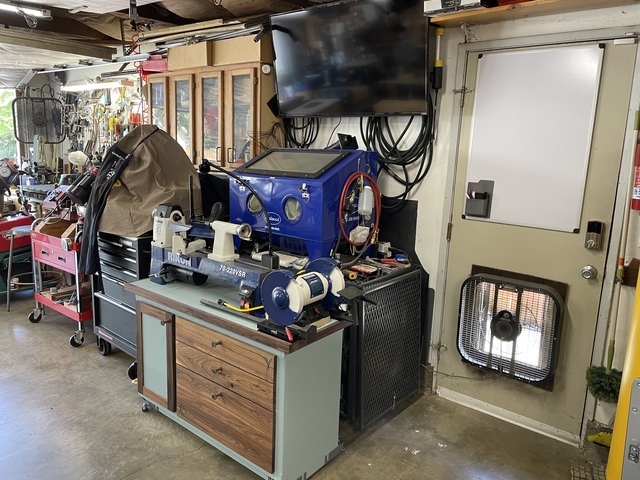
Here’s a circulating fan…
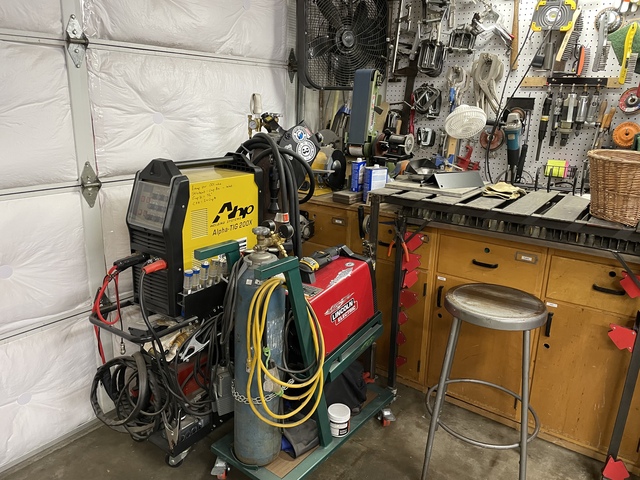
And here’s the small infra-red heater (upper left)
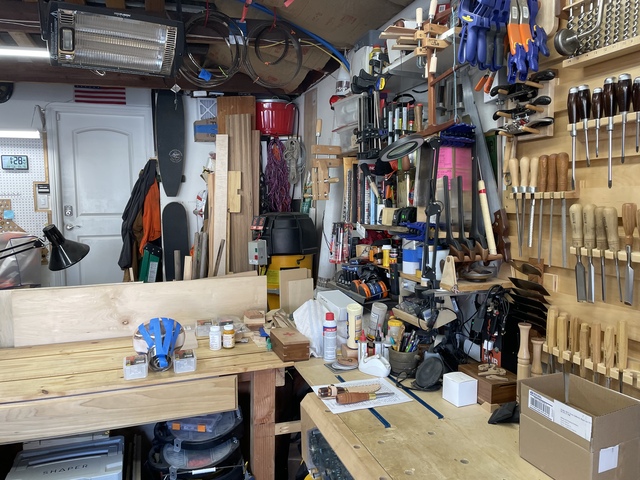
So, let’s see what you’ve got in your shop to beat the heat!…or the cold…
Ryan/// ~sigh~ I blew up another bowl. Moke told me "I made the inside bigger than the outside".
17 Replies
In winter it seldom gets below 12°C which is not too cold for the nightie... seriously, my civies consist of shorts and a medium weight sports shirt which seem to be enough and if it really gets cold some short socks. Winter is never an issue as I could put on some extra clothes if I had any (don't own any longs). Also being an ex skier, I prefer the cold.
I hate the heat, but fortunately in summer, even the hottest days, it seldom get over 25°C in the workshop, which I tolerate and if needed call on my Ryobi air cannon,
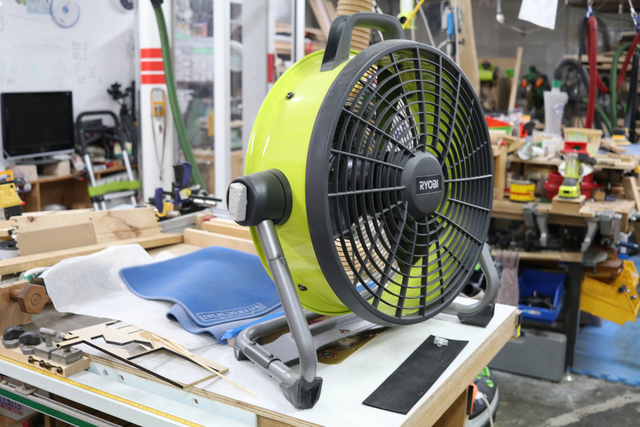
that will operate from either a battery or mains.
If it tops 26°C I turn on my egg-nish-ner which is squirreled away in a corner...
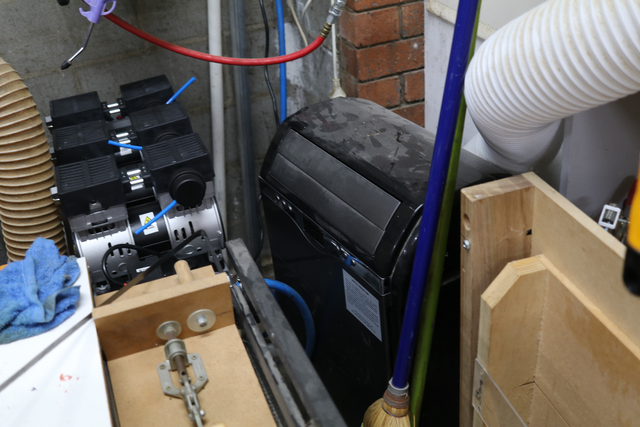
I've only used it about 1/2 dozen times over the past 8 years, to the point that every time I need to use it I have to RTFM to operate it.
During extremes and if the opportunity arises, I occasionally move small jobs to my office... hence my dependence on my Mini Office Workbench.
If your first cut is too short... Take the second cut from the longer end... LBD
When that setup is no longer necessary, I have a dehumidifier with an automatic pump to control humidity, and a dual vented portable AC unit that vents out through the garage door (I cut holes and made a custom bracket for it), for when I need that. Wouldn't mind a mini split, like everyone will say is needed, but the above gets the job done just fine for me for the time being. Significantly cheaper than the mini split, and I don't need a lot of cooling, just when it's up in to the 90+ degrees and humid. I also installed a remote controlled oscillating fan in the corner ceiling near my bench, so even if it's a little warm I can run that and be fine.
MosquitoMade.com
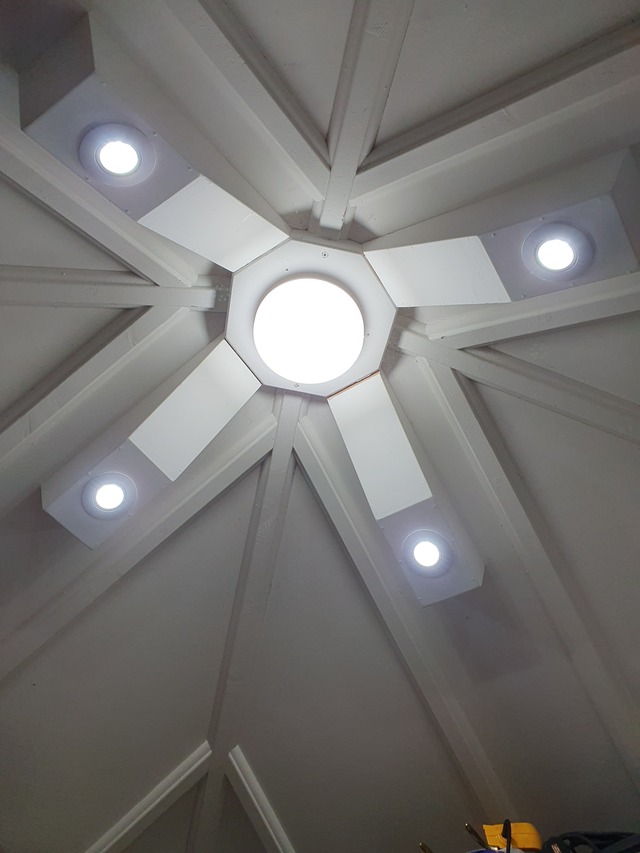
For heating, I use a tiny oil-filled radiator which is ok, but it takes a about 30 mins to get up to temperature and then about 1 hour before you start to feel the effects of it in the room. I also don't like the fact that it has to sit on the floor as space is at a premium.
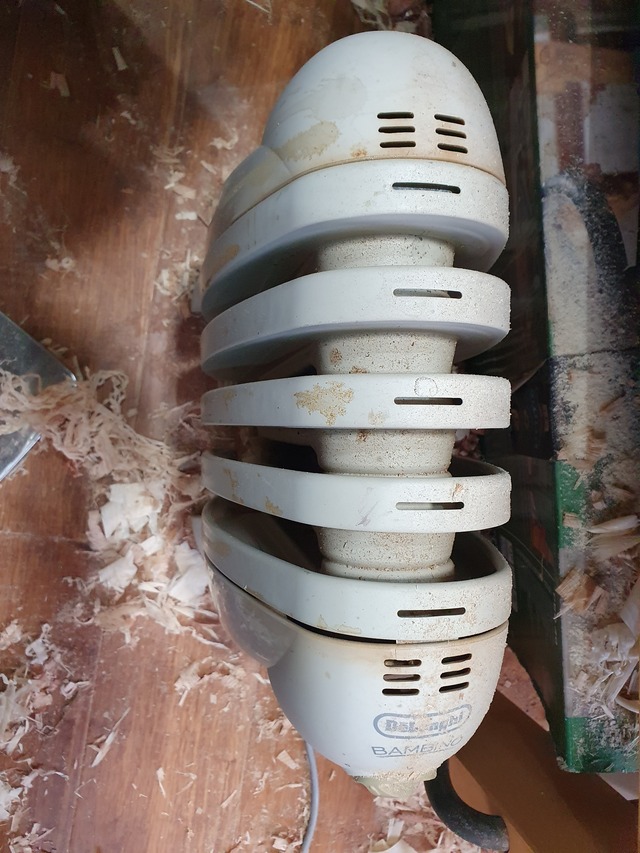
I'm considering getting a small infra-red heater mounted on the ceiling once I'm a bit more organized.
Andy -- Old Chinese proverb say: If you think something can't be done, don't interrupt man who is doing it.
Main Street to the Mountains
In MN, that can mean pretty chilly temps in the winter and a decent amount of heat and humidity in the summer, so I've been thinking about how that would affect both my materials and my motivation. I did have the foresight to at least insulate before sheetrocking, and to get an insulated garage door. In the dead of the winter, and with no active heat source other than the car being parked there after a drive, the space tends to stay just a smidge over freezing.
Because of the biggish air volume, of which I'd only be occupying 1/3 or so, I'm thinking that an infrared heater is probably the short-term, foot-in-the-door heating solution, but I'd be interested to hear what other cold climate folks think.
For the summer, I really don't know.... I'm not terribly concerned about my comfort level - I regularly exercise to the point of sweating buckets - but I'm not sure how the bigger temp and humidity swings would affect materials, so I'm interested to hear feedback on that, as well.
*TONY ** Denver * ALWAYS REMEMBER TO HAVE FUN
--Nathan, TX. Hire the lazy man. He may not do as much work but that's because he will find a better way.
In the winter I heat it with a wood stove. It usually takes a couple of days to burn up all the wood scraps I have generated over the summer then I go to my fire wood pile for fuel. I have a custom made air cleaner for dust with a furnace fan in it that blows across the wood stove and circulates the heat.
One shortcoming of the mini splits is, as with regular heat pumps, that they work best when the temperature is set to a narrow bracket between high and low of say 6 degrees or less 24/7/365.
I still need a solution for the summer though. This summer with outside temps around 100 F the shop stayed around 80 F until I have to open the overhead door and then it gets hot and it stays hot. I'm considering a Quiet Cool garage fan so I can crack open a window in the late evenings and suck some cool air in while exhausting the hot air. Its not an ideal solution because i live in KC and it gets humid here. I have a lot of old cast iron planes in the shop that wont appreciate it but I can run a dehumidifier to help out. Eventually I want a mini split but I think the exhaust fan would still be useful. I'm thinking a guy could build a filter box around it and use it as an air cleaner once the mini split is in.
Ryan/// ~sigh~ I blew up another bowl. Moke told me "I made the inside bigger than the outside".
I'm still on an extension cord and when proper electricity is run, it'll be 120/240 w/30A. This could give way to scalable 100A down the road. For now, electric heat simply isn't an option so I've been using a 12Kbtu propane radiant heater that only works well when I'm ~3' in front of it. With 12' walls and just enough attic flooring to allow heat to pass the joists all the way to the peak, I fear anything that isn't forced air will disappoint. Further skating the line is I counted 15 engines in the shed with at least a dozen of them having some gasoline with them. I do pride myself on an above average sniffer and this time of year doesn't typically generate a bunch of evaporative emissions but what I might not be able to smell can still be dangerous and I'm quite aware of that.
--Nathan, TX. Hire the lazy man. He may not do as much work but that's because he will find a better way.

EDIT: I just looked up the stat to verify my memory. Another way to estimate how much water are pumping into the air is 0.98 gallons per 100,000 BTUH.
--Nathan, TX. Hire the lazy man. He may not do as much work but that's because he will find a better way.
















